Bennemann K.H., Ketterson J.B. Superconductivity: Volume 1: Conventional and Unconventional Superconductors; Volume 2: Novel Superconductors
Подождите немного. Документ загружается.

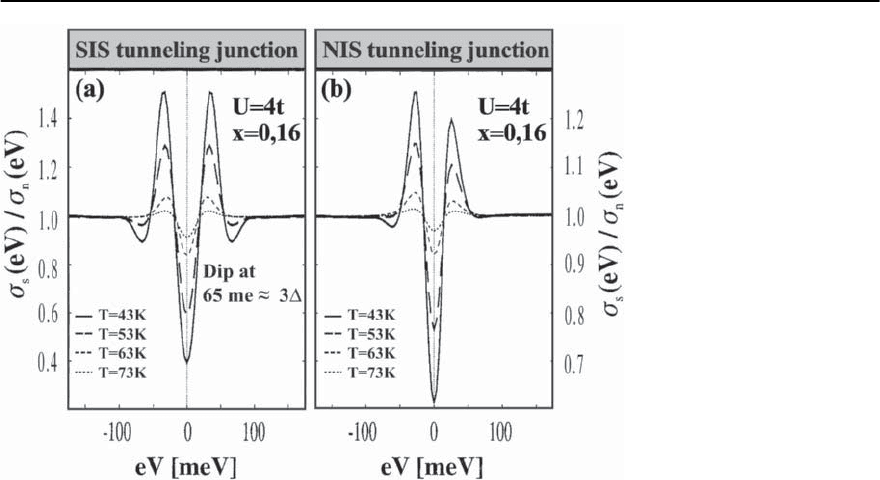
1482 D. Manske,I. Eremin, and K.H.Bennemann
Fig. 23.58. Results for (a)
SIS and (b) NIS tunneling
conductances
s
(eV)using
Cooper-pairing theory due
to spin-fluctuation exchange.
Both quantities are normal-
ized by the normal state
n
(eV) taken at T = T
c
.This
is in fair agreement with
experiments [20,99,151]
spin-fluctuation induced Cooper-pairing in high-T
c
cuprates [99]. It is also interesting to understand why
these dip structures occur at different energies in the
in-plane NIS and SIS measurements. Furthermore,
while the SIS spectrum is symmetric with respect to
the sign of applied voltage the NIS spectra are asym-
metric [151–153].
In Fig. 23.58 we present results [154] for the SIS
and NIS spectra at various temperatures obtained
using the generalized Eliashberg equations.Remark-
ably,bothNIS and SIS tunneling curves show the dip
features at ! = !
res
+
0
and ! = !
res
+2
0
,respec-
tively.Thisagrees withexperimentaldata [20,99,151].
In order to better understand the origin of these
peaks let us remember that the experimental tunnel-
ing conductance in NIS is determined by the quasi-
particle density of states as discussed in the section
on theory. As we already know, the density of states
in cuprates is affected by the scattering of the carri-
ers by antiferromagneticspin fluctuations,whichare
peaked in the superconducting state at !
res
.Taking
into account that the whole spectrum will be shifted
by the value of the superconductinggap
0
, one con-
cludes that the dip seen in the experiments results
from the peak in the spin excitationsspectra at(, )
shifted by the superconducting gap. Therefore, the
position of the dip in NIS is given by:
NIS–dip: ! ≈ !
res
+
0
.
In the SIS tunneling both convoluted density ofstates
have to be taken in the superconducting state and
thus the dip in SIS occurs at:
SIS–dip: ! ≈ !
res
+2
0
.
This agrees with experiments [99]. Furthermore, in
NIS tunneling the curves are asymmetric due to the
fact that the density of states of the normal state is
asymmetric itself (t
, t
= 0). Thus, the effect will
be visible only for the unoccupied states and also
depends on the shape of the Fermi surface for the
different materials. Therefore, depending on the par-
ticular doping level and material the effect may show
up for the positive biasvoltage or on its negative side.
Our results for SIN and SIS tunneling are similar
to those obtained by the spin–fermion model [156].
Regarding the doping dependence of the “dip” fea-
ture we note that it correlateswith the doping depen-
dence of the“resonance peak”seen in INS. Therefore,
the position of the“dip” feature should have qualita-
tively similar doping dependence as expected from
Fig. 23.46. Finally,we would also like to note that re-
cently it was argued [157] that in many cases the“dip

23 Electronic Theory for Superconductivity 1483
Fig. 23.59. SIStunneling conductance at various
doping levels showing the shift of the dip fea-
ture with T
c
.Thevoltageaxisisrescaledinunits
of
0
/e, taken from [155]. Note that SIS spectra
reveal no pseudogap
feature” seen in bilayer cuprates can be produced by
the effects of bilayer splitting. However, recent stud-
ies of the one-layer Tl-based cuprates [158] confirm
the presence of the“dip”feature indicating its intrin-
sic relation to the ’resonance’ peak. In order to iden-
tify the“dip”position seen in bilayer cuprates and its
relation to the “resonance” peak further studies are
necessary.
In Fig. 23.59 we show the experimental results on
SIS tunneling [155]. One can clearly see that the po-
sition of the dip does not occur exactly at 3
0
but,
as expected, at 2
0
+ !
res
.Furthermoreaswasar-
gued in [155] the position of the dip scales simi-
larly to the scaling of the “resonance” peak seen by
INS. Therefore, it appears that the dip structure can
be considered a strong coupling effect analogous to
phonon structures, but the excitations that are re-
sponsible for this feature are the spin fluctuations.
Note that the antiferromagnetic spin fluctuations are
much weaker in the electron-doped cuprates.As a re-
sult the“dip-hump” feature has not been observed in
these compounds so far.
23.4.9 Bilayer Effects
Another interesting effect is the bilayer splitting ob-
served in high-T
c
cuprates. For a long time it was
believed that the enhancement of T
c
in two-layer
cuprates resulted from interlayer coupling in the
elementary unit cell. The bilayer splitting was ob-
served only recently by means of ARPES experi-
ments [74,160,161].As expected the bilayer splitting
can be described by the interlayer hopping term
2t
⊥
cos k
z
cos k
x
−cosk
y
2
,
where t
⊥
= 70 meV. The matrix element t
⊥
describes
hopping term between the CuO
2
-planes and k
z
=0
or corresponds to the bonding and antibonding
bands, respectively. As a result there are two bands
crossing the Fermi level as shown in Fig. 23.60.
The change in the Fermi surface topology is im-
portant for our theory, since the spin fluctuations
are dependent on the amount of nesting. In the bi-
layered cuprates, due to the introduced hopping be-
tween neighboringCuO
2
-planes,the topology of the
Fermi surface changes slightly and most importantly
the nesting shifts to the three-dimensional antiferro-
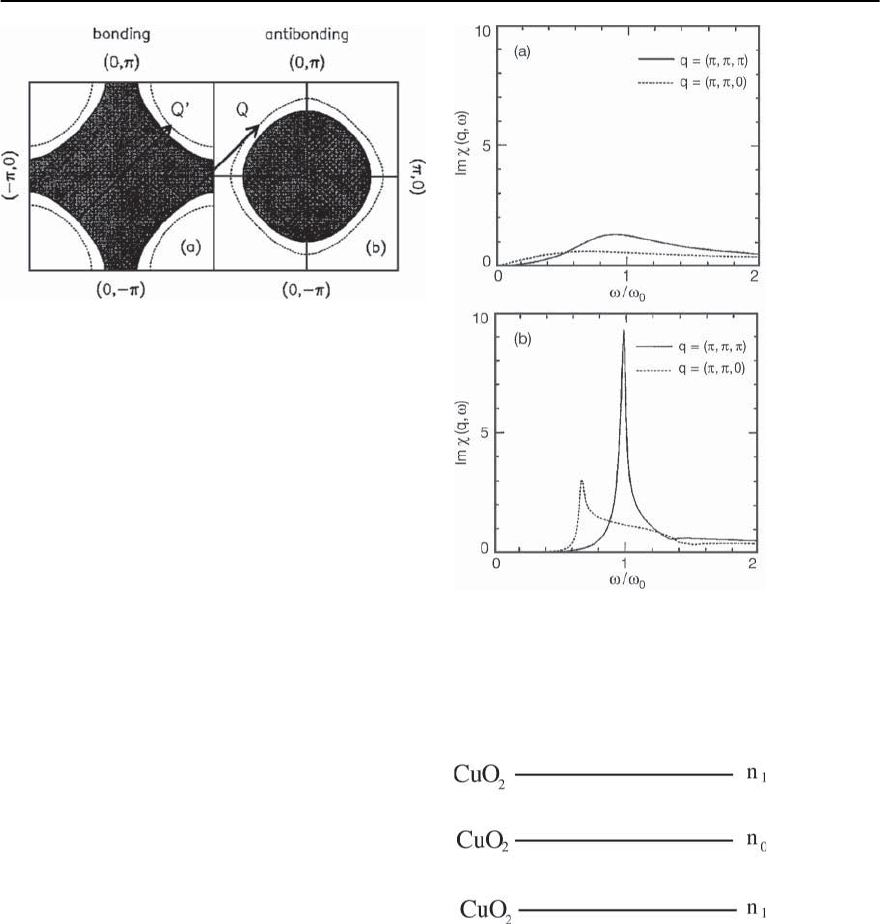
1484 D. Manske,I. Eremin, and K.H.Bennemann
Fig. 23.60. (a) Bonding and (b) antibonding equal energy
contours taken from [159] at optimal doping. The solid
lines bounding the shaded regions are the bonding and an-
tibonding Fermi surfaces, respectively. The arrow labeled
Q corresponds to a (, , ) momentum transfer, which
dynamically nests the bonding Fermi surface with an ex-
cited antibonding state shown by the dotted curve.Amo-
mentum transfer Q’=( , , 0) nowfails to provide nesting.
This yields a smaller T
c
for increasing t
⊥
[101]
magnetic wave vector Q
=(, , ). This is shown
in Fig. 23.61.
The change of nesting is also seen in the calcula-
tionof the spin susceptibilityIm(q, !).Thisisillus-
trated in Fig.23.61(a).The peak in Im in the normal
stateismorepronouncedatQ’ rather than for Q,indi-
cating that in the bilayer cuprates the antiferromag-
netic fluctuations are essentially three-dimensional.
Another interesting feature relates to the resonance
peak formation below T
c
. Similar to the normal state
the “resonance” peak will be more pronounced for
the wave vector Q’ and stronger in its intensity (see
Fig.23.61(b))as compared to the one-layermaterials.
This probably explains why in most cases the reso-
nance peak is visible only in the bilayer cuprates.
What happens with further increase of the num-
ber of CuO
2
-planes per unit cell? Due to crystallo-
graphic position of the inner CuO
2
-plane, already
for the three-layer materials its doping concentra-
tion is sufficiently lower than for the two outer ones,
as illustrated in Fig. 23.62. A further increase of the
number of CuO
2
layers per unitcell does not result in
the enhancement of T
c
for the same reason. Namely,
the inner planes will be less and less metallic and
already for five-layered compounds the inner CuO
2
Fig. 23.61. Change of nesting: Results for spin suscepti-
bility Im(Q, !)versus! for Q’=(, , )(solid curve)
and Q=( , , 0) (dotted curve)for(a)thenormalstate
at T=T
c
and (b) the superconducting state at T=T
c
/2 taken
from [159]. The scales in (a)and(b)arethesameforcom-
parison
Fig. 23.62. Illustration of the change of the doping concen-
tration of CuO
2
-planes in trilayer cuprates. Due to its crys-
tallographic position the inner CuO
2
-plane has a smaller
doping than the outer ones. Therefore, the inner CuO
2
-
plane will be underdoped. This may effectively reduce the
T
c
of the systemifafurtherincreasein the number of layers
takes place. For example, it is known that already in five-
layered cuprate superconductors the inner CuO
2
-plane is
undoped and remains insulating

23 Electronic Theory for Superconductivity 1485
is non-superconducting. This explains the reduction
of T
c
with an increasing number of CuO
2
-planes per
unit cell, n (n > 3).
A final remark we would like to make is on the
value of calculated T
c
in bilayered cuprates. In the
spin fluctuation scenario and using the FLEX ap-
proximation,T
c
decreases in the bilayer cuprates due
to a smaller nesting and the corresponding spin fluc-
tuations at Q’. However, this depends on the momen-
tum dependence of the hopping term. Furthermore,
the spin susceptibility
s
in the odd channel be-
comes larger than its counterpart in the even channel
(roughly factor5 for realistic parameter values).This
has consequences for the resulting magnitude of the
gap function
0
, which also turns out to be larger in
the odd channel. But, all in all, in bilayer cuprates
the essential physics is unchanged. Therefore, the
corresponding “fingerprints” of the spin fluctuation
Cooper-pairing like the “resonance” peak and “dip”
feature seen in INS, and the kink structure in the
elementary excitations seen in ARPES, and SIS/NIS
tunneling spectroscopy should be present. Further
experimental and theoretical studies are expected to
support this.
23.5 Results for Sr
2
RuO
4
23.5.1 Electronic Structure
We begin the discussion of our results for Sr
2
RuO
4
by analyzing their electronic structure.In contrast to
the cuprates the electronic structure of the ruthen-
ates is more complicated. For example, according
to the LDA calculations there are three bands that
cross the Fermi level [107].Moreover,whileone band
is quasi-two-dimensional (xy), the other two bands
(xz, yz) are quasi-one-dimensional. This is shown in
Fig.23.63 where we present our results for the energy
dispersion of the Sr
2
RuO
4
in the RuO
2
-plane (k
z
=0)
using the tight-binding parameters and spin–orbit
coupling as described before.
The main effect of the spin–orbit coupling on
the dispersion is the removal of the degeneracy be-
tween xz and yz-bands as present in the LDA cal-
culation. Therefore, one may say that the spin–orbit
coupling acts likea hybridization.On the other hand,
Fig. 23.63. Calculated energy dispersion of the xy , yz,and
xz-bands in Sr
2
RuO
4
along the route (0, 0) → (, 0) →
(, ) → (0, 0) in the first BZ. The tight-binding parame-
ters are used.The spin–orbit coupling is taken into account.
Note that the energy dispersion of the xy( )-band is two-
dimensional, while xz(˛)andyz(ˇ)-bands are sufficiently
one-dimensional as seen from their dispersion
the character of the xz and yz-bands still remains
one-dimensional. This can also be recognized in
Fig. 23.63. For example, one clearly sees that the
xz and yz-bands are weakly momentum dependent
along the (0, 0) → (, 0) and (, 0) → (, )-
directions, respectively. At the same time the xy -
band is two-dimensional. The reason for this is the
strong overlap between the d
xy
Ru orbital with the
2p
x
and 2p
y
oxygen orbitals. Since Sr
2
RuO
4
shows
a quasi-two-dimensional behavior, it was proposed
originally [54] that only the xy -band plays an impor-
tant role in determining the physical properties of
Sr
2
RuO
4
in the normal and superconducting states.
Actually, this is further supported by the fact that
the flat region of the xy-band leading to a logarith-
mic singularity in the density of states (the so-called
Van-Hove singularity) lies very close to the Fermi
level.
Yetthequestionabouttheroleofthexz and
yz-bands for determining the physical properties
of Sr
2
RuO
4
remains unclear. In Fig. 23.64 we show
the results for the two-dimensional Fermi surface in
ruthenates,which consists of two electron-like Fermi
surfaces of yz nd xy-bands and a hole-like Fermi sur-
face of the xz -band. The filling of each band is ap-
proximately 2/3.The importantfeature that we would
like to stress is a strong nesting of the yz(ˇ)-band
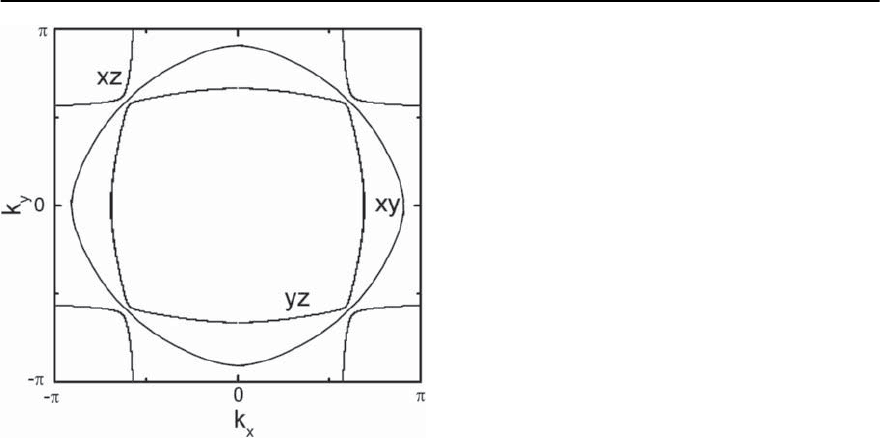
1486 D. Manske,I. Eremin, and K.H.Bennemann
Fig. 23.64. Calculated two-dimensional Fermi surface of
Sr
2
RuO
4
by taking into account spin–orbit coupling. The
Fermi surface consists of three sheets: two with electron-
like topology and one with hole-like topology. Spin–orbit
coupling acts like a hybridization and removes the degen-
eracy of the ˛(xz)andˇ(yz)-bands
at the incommensurate antiferromagnetic wave vec-
tor Q
i
=(2/3, 2/3). This is extremely interest-
ing, since it first indicates an importance of the band
structurefordetermining the normal and supercon-
ducting properties of Sr
2
RuO
4
andseconditshows
the necessity to include all three bands into the the-
oretical analysis. This is in contrast to the cuprates
where the one-band approximation seems to be in
order mostly.
23.5.2 Elementary Excitations: Effects of Spin
Fluctuations
Unfortunately, the complete analysis of the elemen-
tary excitations including all three bands and spin–
orbit coupling has not been performed so far in
Sr
2
RuO
4
. However, there have been several attempts
to analyze the behavior of the elementary excitations
in the “most important” (xy)-band using a pertur-
bation theory up to third order with respect to the
on-site Coulomb interaction U . A three-band Hub-
bard model has been used [162,163].
In Fig. 23.65 we show the results for the real and
imaginary parts of the self-energy versus frequency
for different values of Coulomb repulsion (intraband
U and interband U
) and Hund’s coupling (J and
J
)calculatedatk
F
for the -band. As one can see
this band demonstrates the usual Fermi-liquid be-
havior for different values of the inter-orbitcoupling,
Re£(!) ∼ ! and Im£(!) ∼ !
2
at low energies.
Therefore, it is likely that the nesting in ˛ and ˇ-
bands does not strongly influencethe low-energy ex-
citations of the -band that arise due to a presence of
the ferromagnetic-like fluctuations also originating
from the -band.
On the other hand, at higher energies the self-
energy is sensitive to the inter-orbital interaction,
which can be further observed in the optical con-
ductivity, for example. Another important question
is the behavior of the self-energy in the ˛ and ˇ-
bands. For example, one naively expects that due
to a presence of the strong incommensurate an-
tiferromagnetic fluctuations (IAF) at (2/3, 2/3)
and the quasi-one-dimensional character of these
bandstheir self-energy mayshow a pronouncednon-
Fermi-liquid behavior like in cuprates. Note that
experiments do not show any significant deviation
from the Fermi-liquid behavior. Further studies are
needed.
23.5.3 Dynamical Spin Susceptibility, NMR, and INS
Perhaps one of the most interesting property of the
ruthenates is the dynamical spin susceptibilityin the
normal state. As we discussed in the Introduction,
the understanding of the temperature dependence
of (q, !) is of key significance for determining
the superconducting properties in Sr
2
RuO
4
.Letus
study how the two-dimensional three-band Hubbard
Hamiltonian together with the spin–orbit coupling
can explain the existing experimental data.
In Fig. 23.66 we show the results for the Lind-
hard response functions calculated for the different
bands using their tight-binding dispersions taken
from LDAcalculations[105].Notethat thespin–orbit
coupling is not taken into account.As expected due to
the pronounced nesting of the xz and yz-bands,their
susceptibilities display peaks at Q
i
=(2/3, 2/3),
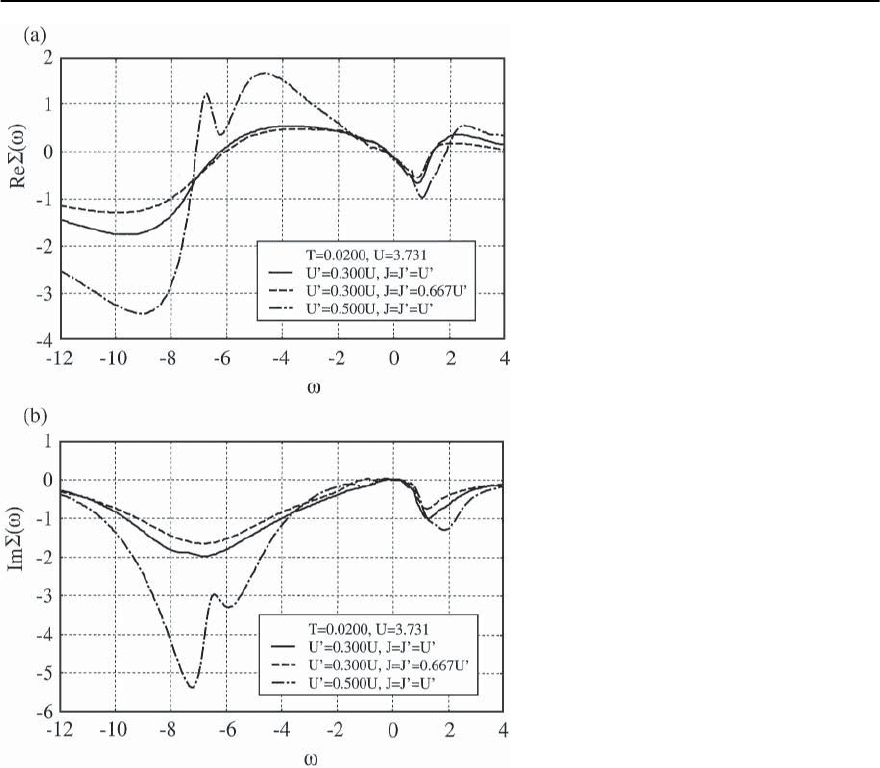
23 Electronic Theory for Superconductivity 1487
Fig. 23.65. The normal state (a)realand(b)
imaginary part of the self-energy for the -
band taken from [162]. U , U
,andJ, J
refer
to the intraband and interband Coulomb and
Hund’s coupling, respectively. The self-energy
£(!)and! are given in terms of the hopping
integral, t
while the xy-band does not show any significant fea-
ture. The response of the xy -band is enhanced due
to the presence of the van-Hove singularity close to
the Fermi level. It becomes clear that the features
observed by INS relate mainly to the magnetic re-
sponse of the xz and yz-bands. However, the present
results cannot account for the observed magnetic
anisotropy, since both longitudinal and transverse
components of the total spin susceptibility are the
same if the term transferring the anisotropy from the
orbital subspace into the spin subspace is neglected.
In order to do this we include spin–orbit coupling.
Using the random phase approximation (RPA) for
every particular band we calculate the longitudinal
and transverse components of the total susceptibil-
ity in the RuO
2
-plane using (23.114) and (23.115)
in Sect. 23.3.4. The real part at ! =0isshownin
Fig. 23.67.As a result of the spin–orbit coupling the
magnetic response becomes very anisotropic along
the whole Brillouin zone. Since the spin and or-
bital degrees of freedom are now mixed, the orbital
anisotropy will be reflected in the magnetic suscep-
tibility.As one can see in Fig. 23.67 the longitudinal
component has a pronounced peak at Q
i
,whilethe
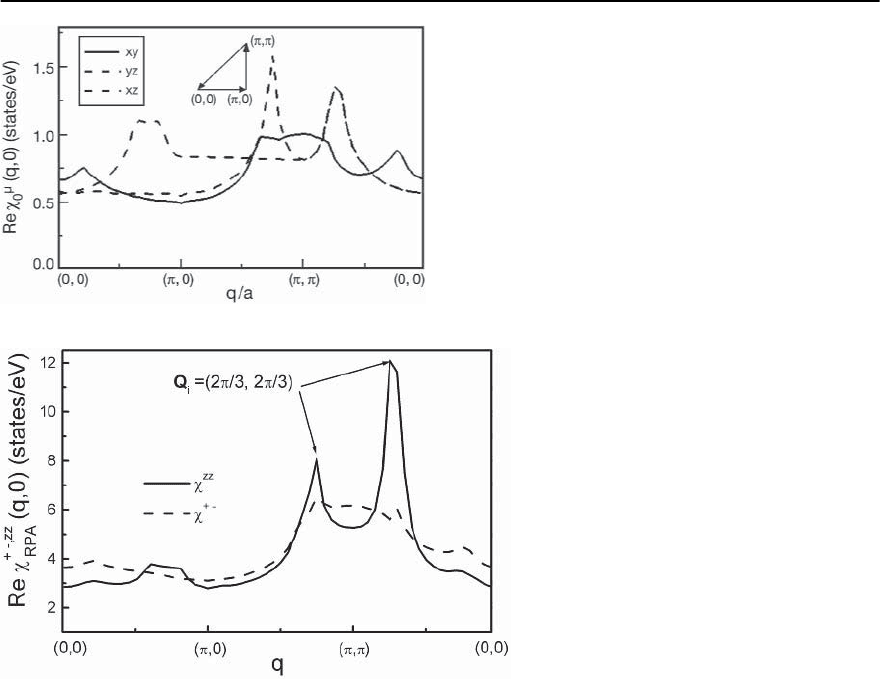
1488 D. Manske,I. Eremin, and K.H.Bennemann
Fig. 23.66. Results without spin–orbit coupling: Calculated
real part of the Lindhard spin susceptibility
0
( refers to
the band indices) in the normal state of Sr
2
RuO
4
along the
route (0, 0) → ( , 0) → (, ) → (0, 0) in the first BZ
for the three different orbitals (xz,yz,andxy) crossing the
Fermi level.Due to the nesting of the xz and yz-bands their
susceptibilities show an enhancement at the incommensu-
rate antiferromagnetic wave vector Q
i
=(2 /3, 2/3).The
response of the xy-band is more isotropic, but significantly
larger than in the normal metal due to the vicinity of the
Van-Hove singularity
Fig. 23.67. Calculated real part of the longitu-
dinal and transverse components of the to-
tal RPA spin susceptibility
+−,zz
RPA
=
+−,zz
, RPA
( refers to the band indices) in the normal
state of Sr
2
RuO
4
along the route (0, 0) →
(, 0) → ( , ) → (0, 0) in the first BZ. Due
to spin–orbit interaction the transverse compo-
nent (
+−
) contains not incommensurate anti-
ferromagnetic fluctuations (IAF) from xz and
yz-orbitals, while in the longitudinal compo-
nent (
zz
) they are enhanced
transverse one does not show these features at all
and is almost isotropic (it mostly reproduces the re-
sponse of the xy-band). In order to understand why
thelongitudinal susceptibility mostly shows thenest-
ing features of the xz and yz-bands one has to re-
member that due to spin–orbit coupling the orbital
component of the magnetic susceptibility cannot be
excluded. Therefore, matrix elements such as i|l
z
|j
and i|l
+(−)
|j have to be taken into account. At the
same time the xz and yz-bands consist of the |2, +1
and |2, −1 orbital states. One can see that while the
longitudinal component gets an extra term due to l
z
,
the transverse component does not, since the tran-
sitions between states |2, +1 and |2, −1 are not al-
lowed.Thus,the contributionof the nesting of the xz
and yz orbitals to the longitudinal component of the
susceptibilityis larger than to the transverse one and
incommensurate antiferromagnetic fluctuations are
almost absent.
In order to see this in the inset of Fig. 23.68 we
show the frequency dependence of the longitudinal
and transverse components of Im calculated for the
wave vector Q
i
=(2/3, 2/3).Despite some struc-
ture seen in the real part of
+−
RPA
at (2/3, 2/3)
(see Fig.23.67)there areno real incommensuratean-
tiferromagnetic fluctuations (IAF) at this wave vec-
tor. On the other hand, the structure in
zz
RPA
at the
same wave vector refers to the IAF fluctuations. The
longitudinal component of Im reveals a peak at
approximately !
sf
= 6 meV in quantitative agree-
mentwithINS experimental data [52].The transverse
component is featureless showing the absence of in-
commensurate antiferromagnetic spin fluctuations.
Thus, the fluctuations in the transverse susceptibil-
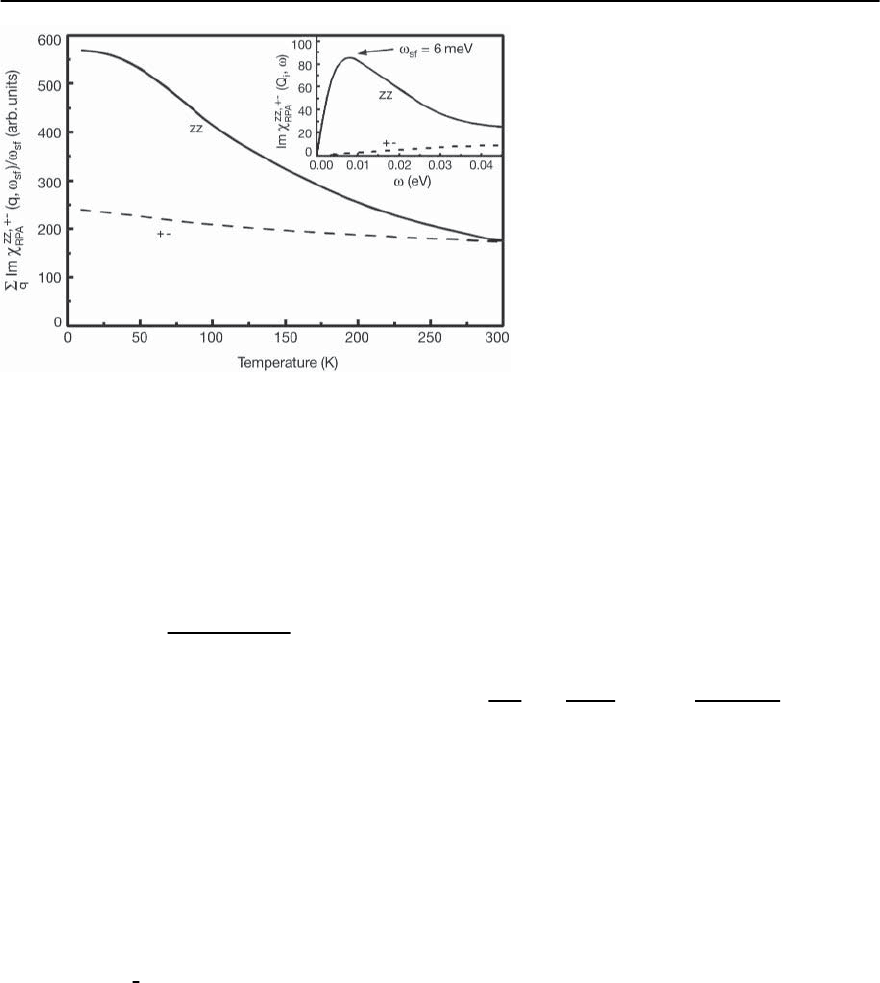
23 Electronic Theory for Superconductivity 1489
Fig. 23.68. Magnetic anisotropy: Temperature
dependence of the imaginary part of the spin
susceptibility divided by !
sf
andsummedover
q. zz and +- refer to the out-of-plane (solid
curve) and in-plane (dashed curve)compo-
nents of the RPA spin susceptibility. In the inset
we show the corresponding frequency depen-
dence of Im
RPA
(Q
i
, !)attheIAFwavevector
Q
i
=(2 /3, 2 /3) and for !
sf
=6meV
ity are isotropic and ferromagnetic-like. Therefore,
antiferromagnetic fluctuations are present only per-
pendicular to the RuO
2
-plane.
In order to demonstrate the temperature depen-
dence of the magnetic anisotropy induced by the
spin–orbit coupling in Fig. 23.68 we display the tem-
perature dependence of the quantity
q
Im
RPA
(q, !
sf
)
!
sf
for both components.At room temperature bothlon-
gitudinal and transverse susceptibilities are almost
identical, since thermal effects wash out the influ-
ence of the spin–orbit interaction. With decreasing
temperature the magnetic anisotropy increases and
at low temperatures we find the important result that
the out-of-plane component
zz
is about twice as
large as the in-plane one:
zz
>
+−
/2 . (23.142)
Ofcourse,thisrelationisonlyvalidclosetothe
wavevector q =
2
3
(, ).We also note that our results
are in accordance with earlier estimations made by
Ng and Sigrist [108]. However, there is one impor-
tant difference. In their work it was found that the
IAF are slightly enhanced in the longitudinal com-
ponents of the xz and yz-bands in comparison to the
transverse one. In our case we have found that the
longitudinal component of the magnetic susceptibil-
ity is strongly enhanced due to orbital contributions.
Moreover, by taking into account the correlation ef-
fects within RPA we show that the IAF are even fur-
ther enhanced in the z-direction.
Finally, in order to compare our results with ex-
perimental data we calculate the nuclear spin–lattice
relaxation rate T
−1
1
for the
17
OionintheRuO
2
-
plane for different external magnetic field orienta-
tion (i = a, b, and c):
1
T
1
T
i
=
2k
B
2
n
(
e
)
2
q
|A
p
q
|
2
p
(q, !
sf
)
!
sf
, (23.143)
whereA
p
q
istheq-dependent hyperfine-coupling con-
stant perpendicular to the i-direction.
In Fig. 23.69 we show the calculated temperature
dependence of the spin-lattice relaxation for an ex-
ternal magnetic field within and perpendicular to
the RuO
2
-plane together with experimental data. At
T = 250 K the spin-lattice relaxation rate is almost
isotropic. Due to the anisotropy in the spin suscep-
tibilities arising from spin-orbit coupling the relax-
ationratesbecome increasingly different for decreas-
ing temperature. The largest anisotropy occurs close
to the superconducting transition temperature, in
good agreement with experimental data [110].
It is still important to see whether our theory
yields the weak ferromagnetic fluctuationsobserved
by means of the NMR Knight shift [164]. The latter

1490 D. Manske,I. Eremin, and K.H.Bennemann
Fig. 23.69. Calculated normal state temperature
dependence of the nuclear spin-lattice relax-
ation rate T
−1
1
of
17
OintheRuO
2
-plane for the
external magnetic field applied along the c-axis
(dashed curve)andalongtheab-plane (solid
curve). Down and up-triangles are experimen-
tal results taken from [110]
Fig. 23.70. The temperature dependence of the uniform
spin susceptibility
+−
RPA
(0, 0) calculated using our RPA the-
ory in comparison with the
17
O Knight shift measurements
in the RuO
2
-plane. The peak is due to thermal activation
involving xy and yz, xz -bands
probes the magnetic fluctuations around q =0.In
Fig. 23.70 we show the results for the temperature
dependence of the uniform susceptibility
+−
RPA
(0, 0).
One can see that a weak temperature dependence
in fair agreement with experimental data [164] oc-
curs and arises due to ferromagnetic-like fluctua-
tions mainly of the xy-band. Note that very recently
ferromagnetic-like excitations were also observed by
means of INS experiments [165]. This also agrees
with our results.
23.5.4 Superconducting Order P arameter
Triplet superconductivity in Sr
2
RuO
4
is of particular
interest. It is important to understand in detail how
the triplet Cooper-pairing is realized in this system
with ferromagnetic and incommensurate antiferro-
magnetic spin fluctuationsat Q
i
=(2/3, 2/3).We
note that the total spin susceptibility (q, !)con-
trols the symmetry of the superconducting order
parameter. Therefore, the spin–orbit coupling plays
an important role in the superconducting state and
in determining the symmetry of the superconduct-
ing state. First, we present the analysis of the super-
conducting gap without taking the spin–orbit cou-
pling into account. We assume that exchange of spin
fluctuations is responsible for Cooper-pairing. Why
is triplet pairing realized despite the strong IAF at
Q
i
≈ (2/3, 2/3)?
For the analysis of superconductivity in Sr
2
RuO
4
we take into account that experiment observes non-
s-wave symmetry of the order parameter, which
strongly suggests spin-fluctuation-mediated Cooper
pairing. Then assuming spin-fluctuation-induced
pairing it is possible to analyze the symmetry of the
superconducting statefromthe gapequationand our
calculated results for (q, !) with pronounced wave
vectors at Q
i
and q
i
. The gap equation is for the band
i given by:

23 Electronic Theory for Superconductivity 1491
i
k
=−
k
,j
[V
eff
(k, k
)]
ij
j
k
2E
j
k
tanh
E
j
k
2k
B
T
,
(23.144)
where E
i
k
=
i
k
2
+
i
k
2
is the energy dispersion of
the band i. Note that the pairing potential V
eff
(k, k
)
is different for singlet ( = s)andtriplet( = tr1)
Cooper-pairing. In order to keep the discussion of
the triplet state relatively simple we restrict ourself
to the case of equal spin pairing (i.e. V
eff
tr1
defined
in (23.104)). The eigenvalue analysis of (23.144) will
yield the symmetry with the lowest energy.
For the determination of the pairing potential we
use the calculated FS, the corresponding density of
states, and the spin susceptibility for Sr
2
RuO
4
and
also follow the analysis by Anderson and Brinkmann
for
3
He [114] and by Scalapino forthe cuprates [166].
We compare the results obtained by assuming singlet
or triplet pairing.
For the equal-spin triplet pairing the effective
pairing interaction is given by
V
eff
tr1
(k, k
)
ij
=−
U
2
2
ii
0
(k − k
, 0)
1−U
ii
0
(k − k
, 0)
(23.145)
+
ii
0
(k − k
, 0)
1+U
ii
0
(k − k
, 0)
−2U
2
ij
0
(k − k
, 0) ,
where the last term occurs only for ˛ and ˇ-bands.
Note that the first two terms refer to the intraband
spin and charge fluctuations, respectively.
For singlet pairing the effective pairing interac-
tion has the form
V
eff
s
(k, k
)
ij
=
U
2
ii
0
(k − k
, 0)
1−U
ii
0
(k − k
, 0)
+ (23.146)
+
U
3
ii
0
(k − k
, 0)
2
1−U
2
ii
0
(k − k
, 0)
2
− U
2
ii
(k − k
, 0) .
Again,the first two terms refer to the spin and charge
fluctuations, respectively, and the last term avoids
double counting. Note that the cross-terms includ-
ing
ij
are small due to the Pauli principle and thus
we neglect them for singlet pairing. Note, the second
term in V
0
comes from ladder diagrams which due
to the Pauli principle do not contribute to the triplet
pairing.
Using appropriate symmetry representations
[167] we discuss the solutions of (23.144) assuming
p, d,orf -wave symmetry of the order parameter in
the RuO
2
-plane:
p
(k)=
0
ˆz(sin k
x
a + i sin k
y
a), (23.147)
d
(k)=
0
(cos k
x
a −cosk
y
a), (23.148)
f
x
2
−y
2
(k)=
0
ˆz(cos k
x
a −cosk
y
a)
× (sin k
x
a + i sin k
y
a) . (23.149)
Here the ˆz-unit vector refers to the d
z
component
of the Cooper-pairs as observed in the experiments
[168]. We present the possible explanation for this
later. These symmetries of the superconducting or-
der parameter must be substituted into (23.144).For
simplicity we first consider the solution of (23.144)
in the RuO
2
-planes and then discuss what is happen-
ing along the c-axis. Note that the largest eigenvalue
of (23.144) will yield the symmetry of the supercon-
ducting order parameter
l
in Sr
2
RuO
4
.
Solving (23.144) in the first BZ down to 5 K we
found that p-wave symmetry yields the largest en-
ergy gain for the xy-band, while for the xz and yz-
bands the situation is more complicated.
One can see that the gap equations for the xy and
yz, xz-bands can be separated due to their weak in-
teraction. For the xy -band the p-wave is the most
stable solution, while for the xz and yz-bands f
x
2
−y
2
-
wave symmetry yields the largest eigenvalue due to
stronger nesting.
Figure 23.71 characterizes the solutions of
(23.144). Note that a good approximation is to lin-
earize (23.144) with respect to
i
l
,i.e.E
i
k
→
i
k
.We
also use tanh(
i
k
/2k
B
T)=1.Thus,themaincontri-
bution to the pairing comes from the Fermi levels.We
present our results for the Fermi surface in the RuO
2
plane. The wave vectors Q
i
and q
i
refer to the peaks
in (q, !). The areas with
f
x
2
−y
2
> 0and
f
x
2
−y
2
< 0
are denoted by (+) and (-), respectively. Notethat the
minus sign in (23.144) is canceled for triplet pairing.
The summation over k
in the first BZ is dominated
by the contributions due to Q
i
for the ˛ and ˇ-bands
and the one due to q
i
for the -band.
As can be seen from Fig. 23.71 in the case of f
x
2
−y
2
-
wave symmetry for the xy-band the wave vector q
i
bridges the same number of portions of the FS with
